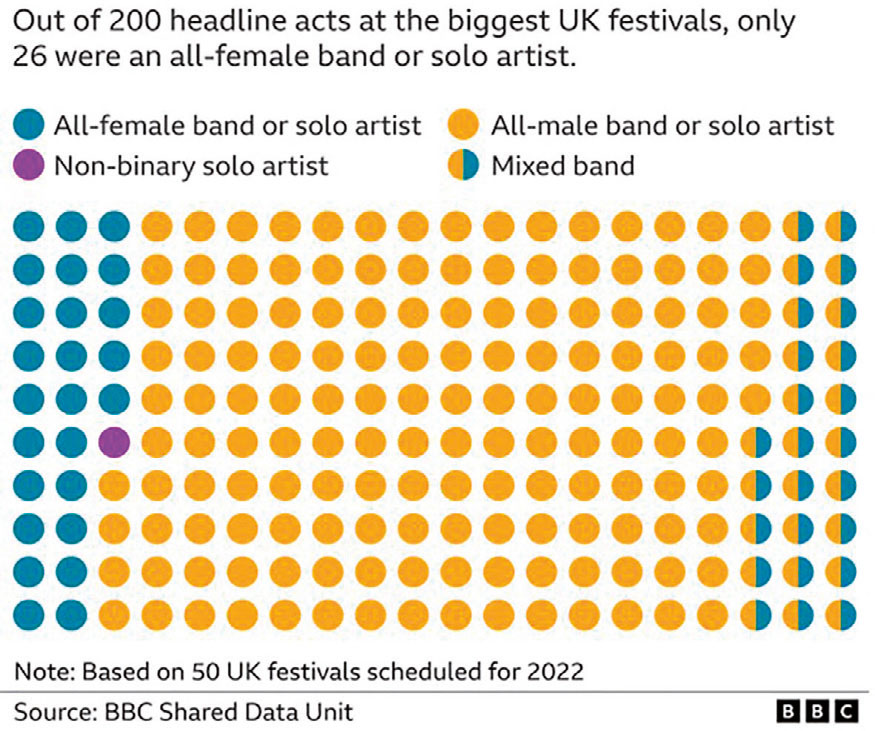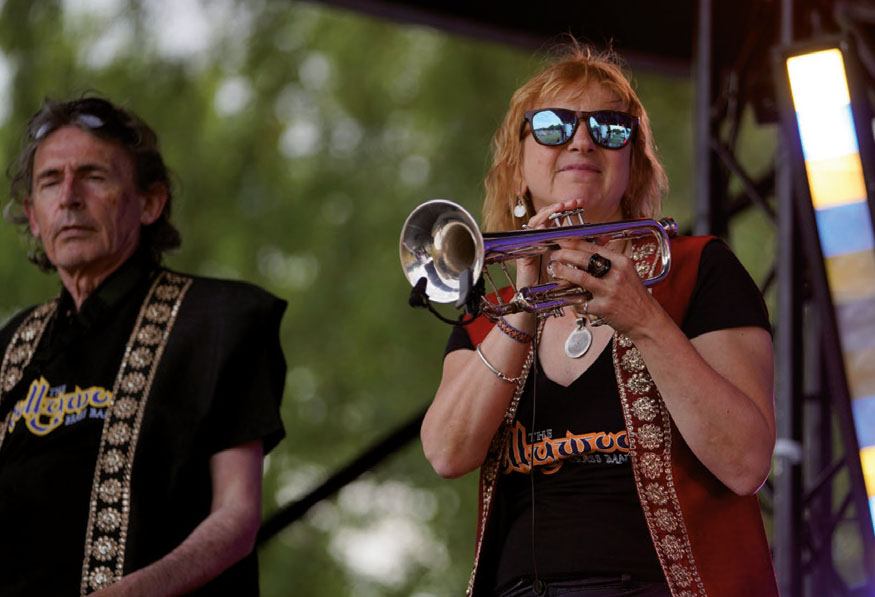
That's a funny instrument for a girl!’ I must have heard this hundreds of times when I was learning the trumpet growing up; but this was back in the last century – can it still be relevant in 2022?
In the summer, my teaching-musician role tilts more to the performing side. While playing at UK street band festivals, I was really shocked by the lack of women playing brass, wind, or drums. The professional players were – with some notable exceptions – male, under 30 and white. Where community and youth bands were present, they were close to 50/50 male/female, a marked difference to the pro bands.
The festivals coincided with the Euros, during which it seemed that the whole country got behind women's football and every 10-year-old girl could see professional football as a possible career path. So, what's happening in music? Why am I not seeing many female professional brass players? Obviously, there are many fantastic female instrumentalists out there, and I can name several female trumpeters, but compared to male players the number is tiny. I particularly noticed the lack of women in street bands, which got me thinking about other brass-heavy genres.
Brass bands
I spoke to Paul Fisher who runs Amersham Band and works for Brass Band England's Brass Foundations. Fisher says there are nine AmBand ensembles, with a really good gender balance throughout. ‘Our Beginner and Brass Roots groups are perhaps 60/40 boys/girls; AmJam (for retired people and daytime learners), Concert Brass, and Community Band are really well balanced, as is our Big Band – I would say closer to a 50/50 split.’
So far so good; however, Fisher goes on to say: ‘My concern is our Championship Section Band. Because the quality has improved and repertoire turnover has become quicker, I'm noticing that some of my female members – all of whom are fantastic players – are struggling to maintain the commitment that they want to put in because of family commitments with their own children.’ Fisher acknowledges that some male members are also struggling with work/life balance.
Jazz
Issie Barratt, founding artistic director of National Youth Jazz Collective (NYJC), makes some salient points: ‘Young female trumpeters we have worked with reported feeling self-conscious during their formative years and were teased by their friends. Female music teachers at girls’ schools say they've sold their brass instruments and bought more flutes and clarinets because parents send brass instruments back with a note saying they don't want their daughters playing something so loud and aggressive. During NYJC's 15 years, I've only met two female trombone players and fewer than 10 female trumpet players.’ These are sobering comments, despite Barratt's high profile as a role model – she appeared on the Woman's Hour 2018 Power List of the top 40 most influential women in the music industry.
Beth Ismay, learning and participation coordinator for the National Youth Jazz Orchestra, says ‘NYJO is very proud to have some talented young women who play brass, wind and drums, providing essential female role models.’ She acknowledges that some Big Bands have felt like ‘boys clubs’ in the past and says, ‘NYJO is proactive in creating the right environment to allow all our musicians to flourish, and we provide all members with a handbook making clear that sexism or discrimination in any form won't be tolerated.’
Festivals and airplay
Perhaps girls are entering the profession playing other ‘traditionally male’ instruments like guitar, bass, drums, or are becoming producers. Somehow, I doubt it; a BBC study found that only one in 10 headliners at the UK's top music festivals this summer were women, despite a 2018 promise to achieve a ‘50/50’ gender balance across their line-ups by 2022.

Source: BBC Shared Data Unit
The 2021 edition of the Gender Disparity Data report into UK radio airplay of British artists showed a ‘slight improvement’ on the previous year – from January to August women accounted for 20 per cent of airplay, an increase of 1 per cent from 2020; mixed-gender collaborations represented 34 per cent, up 4 per cent, and 44 per cent of the top 50 British artists played on UK radio were male (down 7 per cent). Female songwriters and composers represented 23.2 per cent, up from 19 per cent the previous year. Things are moving in the right direction, but progress seems to be painfully slow.
What's the gender balance like in orchestras? A research article by UCL (Sergeant and Himonides, 2019) confirmed my suspicions that players of the violin, flute and harp were mainly female and that males predominated in all brass sections.
What can we do?
Girls and boys learn alongside each other in whole class lessons at primary school, but are enough schools teaching brass, or are schools turning to the ukulele as a universally popular instrument? A 2020 survey by ABRSM found that 15 per cent of WCET lessons are on ukulele.
What stops girls continuing with brass instruments through secondary school and beyond? I suspect that the street band players I saw came through conservatoire jazz courses. A quick search brings up studies that confirm this – there is a fall off of girls playing brass at secondary school, with few going on to study jazz. This is exacerbated by approaches to improvisation along with social pressures to play ‘feminine’ instruments. Don't even get me started on the issue of image; on The Lost Women of British Jazz (BBC Sounds), the legendary band leader Ivy Benson said, ‘You've got to look like Marilyn Monroe and play like Buddy Rich.’
Taking action
The National Plan for Music Education devotes a chapter to supporting musical progression and furthering development, placing an emphasis on exposing young people to the diversity of roles in the music industry. The Plan suggests we should ‘support young people's sustained engagement and musical development’ by:
- Facilitating sustained access to varied experiences, opportunities and genres;
- Ensuring sustained access to role models and mentors.
Ask your Music Hub if they have contact with local music employers and organisations who can help to make connections between music education and progression into musical careers; invite female role models into your school. Over the next few years, all Music Hub lead organisations should be appointing a designated inclusion lead and implementing an inclusion strategy – find out how they are supporting girls into the industry.
Be pro-active: Paul Fisher says, ‘I'm very keen to have as balanced an ensemble as possible so I've recently changed plans to make our rehearsal schedule more flexible, including no rehearsals in school holidays.’ NYJO aims to remove as many barriers to opportunity as possible by delivering ongoing targeted initiatives like half-term Women in Jazz projects, female-led jazz jams and Women of NYJO meetings.
They say, if you can't see it, you can't be it, so let's make female instrumentalists visible in the classroom and band room and help to get girls out into the music business.
 © Courtesy Bollywood Brass Band
© Courtesy Bollywood Brass Band
Kay Charlton playing with the Bollywood Brass Band at the Durham Brass Festival 2022
Practical suggestions
- Put positive images of female instrumentalists on your display wall
- Show video clips that include female performers/conductors/band leaders
- When inviting professional musicians into your school, make sure there are women in the ensemble
- Include improvisation in every music lesson so it doesn't become a barrier to playing in genres other than classical music
- Promote female musicians even more during Women's History Month (March).
Female-led bands and brass players to watch
- Kokoroko
- Alison Balsom
- Tine Thing Helseth
- Laura Jurd
- Yazz Ahmed
- Valaida Snow
- Melba Liston
- Annie Whitehead








